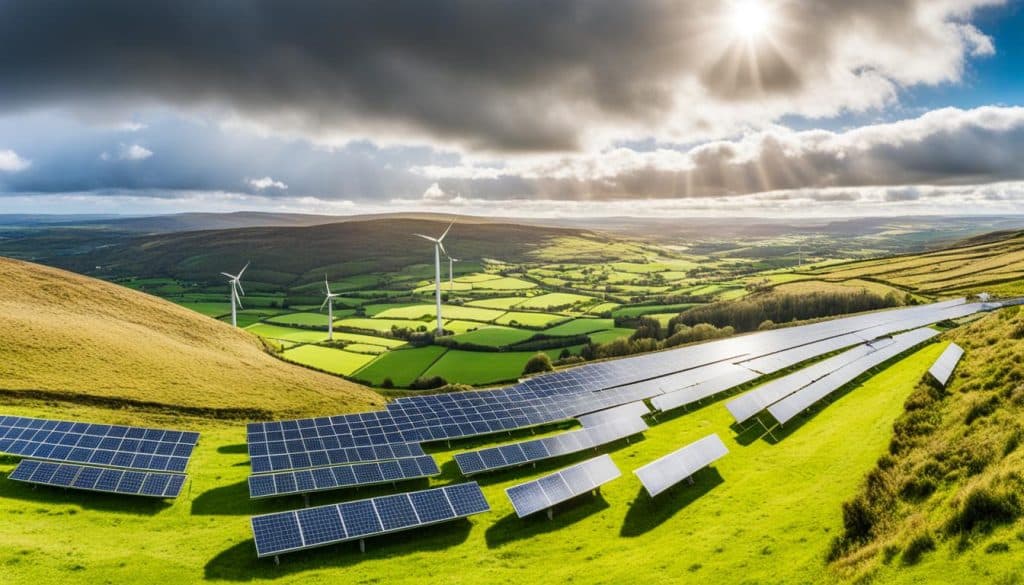Renewable energy is key to Ireland’s plan to combat climate change. It focuses on boosting security, saving costs, and being sustainable. The country has laid out goals for using renewable energy in various areas.
- Renewable Energy Targets in Ireland
- Renewable Energy Share in Ireland
- Ireland’s Geographical Advantage for Renewable Energy Production
- Ireland’s Ambitious Climate Action Plan
- Global Efforts in Renewable Energy Transition
- Tackling Agricultural Emissions in Ireland
- Ireland’s Decarbonization of the Electricity System
- Ireland’s Advantages for Renewable Energy Production
- Ireland’s Progress in Renewable Energy Attractiveness
- Global Market Highlights in Renewable Energy
- The Role of Corporate Power Purchase Agreements in Ireland
- Ireland’s Transition to a Green Economy and a Hub for Renewable Energy Production
- The Future of Renewable Energy in Ireland
- Conclusion
- FAQ
- Source Links
Key Takeaways:
- Ireland is committed to developing renewable energy as part of its climate change strategy.
- The country has set targets for renewable energy in different sectors, such as transportation and electricity.
- Ireland aims to achieve cost competitiveness, sustainability, and energy security through renewable energy.
- Ireland’s progress in renewable energy makes it an example of sustainable practices.
- The country’s efforts contribute to a greener and more sustainable future.
Renewable Energy Targets in Ireland
The RED and REDII have set targets for renewable energy in Ireland. These targets are key for the country’s shift to a cleaner and more sustainable energy model. Let’s explore the renewable energy goals in Ireland.
Overall Renewable Energy Share Targets
In 2020, Ireland’s aim was for 16% of its energy to come from renewables. But, it only reached 13.5%. For 2030, the EU wants 32% of energy from renewables, an aim Ireland has raised to 34.1%. This shows Ireland is eager to up its renewable energy efforts in the next decade.
Renewable Energy Share in Transportation
By 2020, Ireland reached its 10% renewable transport energy target. By 2030, the aim is 14%. This effort showcases Ireland’s push towards more eco-friendly transport and lessening its carbon footprint.
The RED and REDII guide Ireland to up its renewable energy use and promote green strategies. There is a definite plan to make Ireland’s energy more sustainable.
| Targets | 2020 | 2030 |
|---|---|---|
| Overall Renewable Energy Share | 16% | 34.1% |
| Renewable Energy Share in Transportation | 10% | 14% |
Renewable Energy Share in Ireland
Renewable energy is vital for Ireland’s sustainable future. It focuses on three main sectors: electricity, transport, and heat. By turning to clean energy sources, it helps cut down on harmful carbon emissions.
Renewable Electricity
In Ireland, renewable electricity leads the way. Wind power is a major reason for this. Wind farms use the power of Ireland’s winds to make clean energy.
Renewable Transport
Reducing emissions in transportation is key. Most of the clean energy used comes from biofuels. These come from natural materials, offering a green way to travel.
Renewable Heat
Heating takes up a lot of energy in Ireland. Biomass is key for making heat in a clean way. It uses materials like wood pellets to reduce carbon.
The use of renewable energy is rising across all areas. Ireland is committed to reaching its green energy goals. This shows its promise to a more sustainable future.
| Sector | Primary Source |
|---|---|
| Electricity | Wind Energy |
| Transport | Biofuels |
| Heat | Biomass |
Ireland’s Geographical Advantage for Renewable Energy Production
Ireland is in a spot perfect for making wind energy. It sits by Europe’s western coast and the huge Atlantic Ocean. This means it gets strong, steady winds, great for producing a lot of wind energy.
With this amazing wind exposure, Ireland could be big in making offshore wind energy in Europe. It’s already the second-best in wind electricity production on land in Europe. This shows how serious Ireland is about green, renewable power.
The Potential of Offshore Wind Energy in Ireland
Ireland doesn’t just have great wind on land. It also has a lot of room for making wind energy at sea. This is because it’s close to the deep waters of the Atlantic. With better offshore wind tech that’s cheaper, Ireland is ready to make the most of all this.
To show how much Ireland could do with offshore wind, we could make a detailed table:
| Offshore Wind Potential in Ireland | Estimated Capacity (GW) |
|---|---|
| Northwest Coast | 50 |
| Western Coast | 35 |
| Southeast Coast | 25 |
This table lays out how much wind energy can be made all around Ireland’s coastline. It shows the big opportunity for offshore wind power.
In the end, Ireland’s place by the Atlantic makes it great for making renewable power. With strong wind energy on land and a lot of potential at sea, Ireland is stepping up as a green energy leader.
Ireland’s Ambitious Climate Action Plan
Ireland is making big moves to fight climate change with its new plan. It aims to drop its electricity system’s carbon footprint by 80% come 2030. It also wants to cut carbon emissions by 51% in the next decade.
This strategy shows how serious Ireland is about sustainability and a green economy. It involves changes in energy, transport, waste, and farming ways. New ideas and changes in energy and waste management are key to this plan.
Getting rid of fossil fuels from electricity is a major goal in Ireland. They plan to use more wind, sunlight, and water power. This change not only fights climate change but also opens doors for new green companies.
But, electricity is just one step. Ireland also wants to lessen transport carbon output. They aim to do this by backing electric cars and making public transport better. The plan won’t work without good roads and places for buses and trains.
Clean Energy Innovation and Investment
Ireland is asking companies to join the green wave. The plan knows private businesses have a big part to play. With new, green ideas and actions, companies can help cut down emissions and make Ireland cleaner.
Putting money into clean energy tech is key for Ireland’s plan to work. The government offers help and prizes for green power projects. This move gives companies a chance to grow and help Ireland turn greener.
Collaboration and International Commitments
Ireland’s climate plan matches its promises to the world under the Paris Agreement. Ireland works with other nations to fight climate change. Sharing ideas helps speed up the move to a green, low-carbon life.
The Irish plan could inspire other countries. By focusing on green energy and less pollution, Ireland aims for a better, greener world for all.
| Targets | 2030 Goals |
|---|---|
| Decarbonize electricity system | 80% reduction |
| Reduce emissions | 51% reduction |
| Renewable energy share in electricity | 70% renewable electricity |
| Transport emissions | Significant reduction |
| Waste management | Improvement in waste management practices |
Global Efforts in Renewable Energy Transition
Countries such as France and Germany are working hard to cut down on carbon emissions. They are focusing on switching to renewable energy sources. France hopes to be carbon neutral by 2050 and uses a lot of nuclear energy.
Germany is aiming for net-zero emissions by 2045. They are also getting into making “green” kerosene. These steps show how vital it is for the whole world to move to renewable energy.
Tackling Agricultural Emissions in Ireland
Agriculture has a big role in Ireland’s greenhouse gases. So, the country is making efforts to be more sustainable. It’s focusing on reducing the methane emissions mainly coming from farms.
The Ag-Climatise roadmap is a key part of this effort. It sets a goal to cut all agricultural emissions to zero by 2050. The plan includes farming methods that are better for the planet and encourage taking care of nature.
Irish farmers are looking at smart ways to farm. This means using things like precision farming, going organic, and planting more trees. These methods cut down on harmful emissions and keep the soil healthy for years to come.
They are also exploring new tech, like machines that catch methane before it escapes into the air. These machines turn methane into power, which is good for the planet. It’s a win-win for everyone.
Ireland wants its farming to be both green and profitable. The plan to cut down on emissions is a step towards a better future for the Earth. It’s about making farming more sustainable, even as the climate changes.
Ireland’s Decarbonization of the Electricity System
Ireland is focused on making its electricity cleaner, lowering its impact on the environment. It aims to cut carbon emissions by 80% before 2030. This push will make Ireland a key player in producing green energy.
Wind power is essential to Ireland’s plan to cut carbon. It’s using its windy lands to boost renewable energy. This move will help reduce its need for oil and gas.
Getting more of its power from renewable sources is good for Ireland and the planet. It will not only cut pollution but also grow its economy and spark new ideas.
Here’s a look at how Ireland’s efforts are paying off in reducing pollution and boosting clean energy:
| Year | Renewable Electricity Generation (TWh) | Carbon Emissions Reduction (Million Tonnes CO2eq) |
|---|---|---|
| 2015 | 15.2 | 9.8 |
| 2016 | 17.5 | 10.5 |
| 2017 | 21.3 | 11.9 |
| 2018 | 25.6 | 13.4 |
| 2019 | 29.1 | 15.2 |
The data shows Ireland is steadily improving its renewable energy production. This has led to less pollution in the air. It proves Ireland is on the right path towards cleaner energy.
Ireland plans to keep investing in green energy. With more research and better laws, it wants to speed up its clean energy switch. This not only helps the earth but also makes energy safer in the long run.
Ireland’s Advantages for Renewable Energy Production
Ireland is in a perfect spot for making renewable energy. It gets lots of wind from the Atlantic. This makes it great for creating wind power. In Europe, Ireland is second in making wind power from the land.
Ireland aims to make an impressive 70GW of renewable energy. This shows their strong plan for clean energy. They want to be a top country moving towards less use of carbon.
But Ireland’s plans go even further. They want to sell a lot of renewable energy, even hydrogen. This could lead to big chances for growth. It also helps the whole world by cutting down on gases that heat up the Earth.
| Variety of Renewable Energy Sources | Advantages |
|---|---|
| Wind Energy | Abundant wind resources, both onshore and offshore |
| Solar Energy | Sufficient solar radiation, especially during summer months |
| Bioenergy | Potential to utilize agricultural, forestry, and waste resources |
| Hydroelectric Power | Availability of rivers and potential for small-scale hydroelectric projects |
Ireland’s Progress in Renewable Energy Attractiveness
Ireland is working hard in the field of renewable energy. This effort is showing results. It is becoming a top pick for investments in renewable energy. The EY Renewable Energy Country Attractiveness Index ranked Ireland 12th. This shows the world is noticing Ireland’s steps towards a greener future.
One big reason for Ireland’s climb in the ranks is offshore wind energy. It’s reaching agreements with the UK for offshore wind projects. This makes Ireland a great place for those wanting to invest in renewable energy.
The country is also seeing more interest from big companies. These companies are making deals to buy green energy directly from producers. This helps not only these big renewable projects but also shows there’s a real desire for clean energy.
Both local and international investors are keen on Ireland’s green energy plans. This is because of the good rules, strong setup, and helpful policies Ireland has made. Ireland’s achievements in the renewable energy field are promising. They signal towards a future full of growth and new ideas.
Ireland’s Progress in the EY Renewable Energy Country Attractiveness Index
| Year | Ranking |
|---|---|
| 2018 | 19th |
| 2019 | 18th |
| 2020 | 14th |
| 2021 | 12th |
Global Market Highlights in Renewable Energy
The renewable energy market is always growing, with big names leading the charge. The EY Renewable Energy Country Attractiveness Index (RECAI) shows us which markets are at the top. These insights are crucial for understanding this exciting sector.
Recently, the top spots in the index were held by the United States, Germany, and China. It shows they’re serious about creating a green future. These countries have really put their money into green energy.
Renewable Energy Country Attractiveness Index (RECAI) Rankings:
| Ranking | Country |
|---|---|
| 1 | United States |
| 2 | Germany |
| 3 | China |
The Nordics are also moving up the ladder. Denmark, Sweden, and Norway are climbing the ranks. They’re making solid steps towards their green energy goals.
Another standout is Poland, now at 15th place. It’s due to their efforts in benefiting onshore wind and solar projects. Their new laws help them stand out, showing they’re keen on green.
High-ranking Nordic countries in the RECAI:
- Denmark
- Sweden
- Norway
Denmark, Sweden, and Norway are leading the renewable energy race through their unique approach. They use their natural gifts and new tech to move forward. They are playing a significant role in creating a greener tomorrow.
Countries need to keep pushing for more renewable energy. The RECAI helps them see where they stand and where they can do better. It’s all about learning from each other to be the best in green energy.
The renewable energy market is crucial for our planet’s health. It’s good to see countries making real efforts. By choosing green energy, they are choosing a clean and sustainable future.
Keep reading to find out more about how Corporate Power Purchase Agreements (CPPAs) help in Ireland’s green push.
The Role of Corporate Power Purchase Agreements in Ireland
More and more companies in Ireland are using Corporate Power Purchase Agreements (CPPAs). This shows that big businesses are serious about investing in renewable energy. With these agreements, companies promise to buy renewable energy over the long term. This is key for Ireland to reach its goals of using less carbon and turning to greener energy.
CPPAs are great for pushing investment in renewable energy. They give developers the confidence they need by ensuring a fixed income. This allows new projects like wind farms and solar panels to get off the ground. By making deals with companies, those producing renewable energy get the support they need.
CPPAs let both businesses and the planet win. Companies get a steady and eco-friendly energy supply at good prices, helping their own green efforts. Meanwhile, energy makers have the cash to grow and meet Ireland’s green energy aims.
These agreements are key to making Ireland’s economy more green. They boost the need for renewable energy, which means more cash pours into the sector. This results in more projects and more jobs. It also helps power up transport and heat in a cleaner way, cutting down on harmful gases.
In the big picture, Corporate Power Purchase Agreements are making a real difference in Ireland. They show how companies can lead the way in supporting green energy growth. By signing up for these long deals and backing big green projects, businesses help Ireland move towards a future of cleaner energy.
Ireland’s Transition to a Green Economy and a Hub for Renewable Energy Production
Ireland is making a big move towards a green economy. It has set strong goals for using renewable energy. This paves the way for Ireland to be a key player in producing renewable energy globally.
The country plans to majorly cut its use of fossil fuels. By 2030, it aims for 70% of its electricity to come from renewables. This change will not just help the planet by cutting down on harmful gases. It will also bring new jobs and lead to more economic growth in the renewable sector.
Ireland is in a great spot to make the most of its wind energy. The strong winds from the Atlantic are perfect for generating power. Not surprisingly, it’s among the best in Europe at producing wind energy on land.
But it’s not just wind that’s Ireland’s strong suit. The country also has big potential in solar and biomass energy. Its focus on new technology and research in the renewable sector is helping. This effort makes Ireland a leader in the green economy.
Ireland’s Advantages for Renewable Energy Production
| Advantage | Description |
|---|---|
| Geographical Position | Ireland’s location facing the Atlantic provides consistent and abundant wind resources, making it ideal for wind energy production. |
| Renewable Energy Potential | Ireland has the potential to establish 70GW of renewable energy capacity, creating opportunities for significant energy production and export. |
| Offshore Wind Energy | With its extensive coastline, Ireland has the potential to become a major player in offshore wind energy production in Europe. |
| Innovation and Research | Ireland’s commitment to innovation and research in renewable energy technologies drives advancements in production and storage. |
Ireland has a strong chance to lead the world’s green economy. By going big on renewable energy, Ireland can become a big seller of clean power. This will set it apart in the renewable energy market and help make the future more sustainable for all.
The Future of Renewable Energy in Ireland
Ireland is stepping up its efforts in renewable energy and reducing carbon. The country is aiming for a greener future. It’s making big moves to shift to a renewable energy economy. This effort is key to the global push for sustainability.
COP 28, a big climate meeting coming up, is a key moment for Ireland. It’s a chance for Ireland to share its success with the world. Ireland will discuss its green achievements and learn from others. This event is vital for Ireland to work with other countries on new green projects.
In Ireland, the future looks promising for renewable power. The nation is doing well in wind and solar energy. It also aims to cut pollution and protect the environment for future people. Ireland is really serious about fighting climate change.
Conclusion
Ireland leads the world in renewable energy, showing its drive for a green future. It has big goals and has made huge steps in making more renewable energy. Its position as a top player comes from its great land, good weather, and strong efforts to cut carbon.
The country is now a top choice for green investment, pulling in companies from all areas. This shows Ireland as a place where businesses want to be, both as an investor and a maker of green energy. It’s a model for others, urging them to pick up the pace on their renewable energy plans.
Looking forward, Ireland’s role in renewable energy is crucial for the planet’s future. It’s smartly using what nature has given, working with others across the globe. This positions Ireland to lead the fight against climate change, aiming for a world powered mainly by renewable sources. It’s all creating a future that’s both greener and stronger for everyone.
FAQ
Q: What are the renewable energy targets in Ireland?
Q: What is the renewable energy share in Ireland?
Q: What is Ireland’s geographical advantage for renewable energy production?
Q: What is Ireland’s ambitious climate action plan?
Q: What are the global efforts in renewable energy transition?
Q: How is Ireland tackling agricultural emissions?
Q: What is Ireland’s goal for decarbonizing the electricity system?
Q: What are Ireland’s advantages for renewable energy production?
Q: What is Ireland’s progress in renewable energy attractiveness?
Q: What are the global market highlights in renewable energy?
Q: What is the role of Corporate Power Purchase Agreements in Ireland?
Q: How is Ireland transitioning to a green economy and a hub for renewable energy production?
Q: What is the future of renewable energy in Ireland?
Q: Is Ireland rising as a renewable energy leader?
Q: What does Ireland’s rise as a renewable energy leader mean for the future?
Source Links
- https://www.seai.ie/data-and-insights/seai-statistics/key-statistics/renewables/
- https://www.ey.com/en_ie/news/2023/11/ireland-moves-up-the-rankings-in-global-renewable-energy-development-attractiveness
- https://www.openaccessgovernment.org/ireland-could-become-european-leader-in-renewable-energy-production/135942/

















